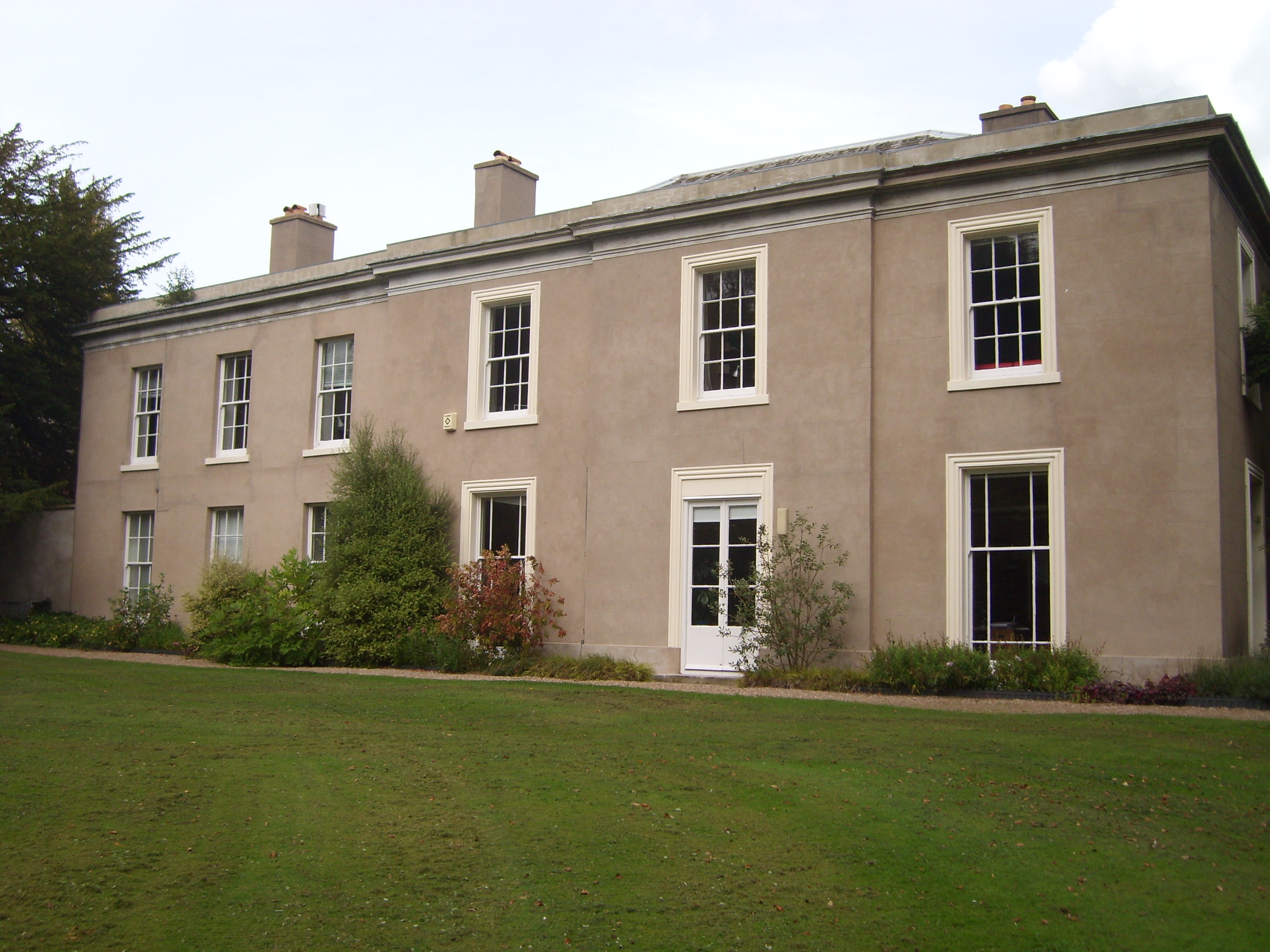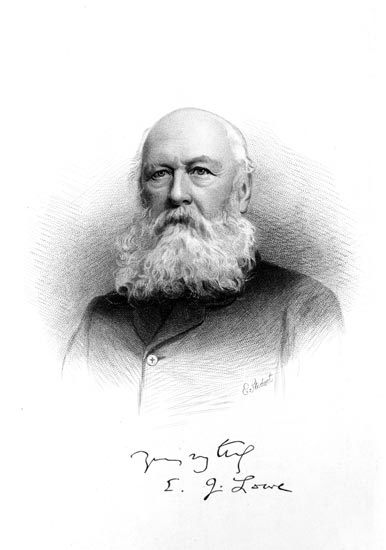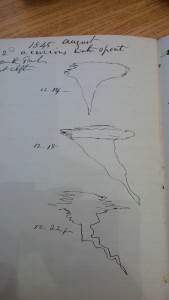
June 4, 2015, by Lucy
Edward Joseph Lowe and extreme weather observations
This week I thought I would write about a weather observer from Nottingham who completed much of his work just a couple of minutes walk from my office. Edward Joseph Lowe (1825-1900) was born in Highfield House, University Park, now home to the Centre for Advanced Studies of the University of Nottingham. He is probably most famous for his work on ferns, but he was also very interested in the weather, and particularly atmospheric phenomena like zodiacal light, the aurora borealis, halos and meteors. A founder member of the Royal Meteorological Society, as well as a member of numerous other learned societies including the Royal Society, the Geological Society and the Linnaean Society, Lowe was apparently affectionately known at ‘The Big Snowflake’, a reference to his big snowy white beard!
Lowe began his observations at Highfield House at the age of 15 (his father had added an observatory to the house), and much of his published work is based on observations at Highfield, including, ‘Observations on 287 Thunder Storms, made at Highfield House near Nottingham’, and ‘On the Mean Temperature of Highfield House near Nottingham from the year 1810 to the year 1850’. Lowe was keen to establish a public observatory in Nottingham and in 1854 a site near Mapperley was chosen. Unfortunately the promised government funding for the observatory was withdrawn. However, the following year Lowe was able to set up the ‘Lawson observatory’ (named after Henry Lawson, the man who had agreed to donate his instruments to the casue) in his own home, which was now in Beeston – Broadgate House – which had been purpose built as an observatory a few years earlier (today there is a blue plaque on the wall outside the entrance to the house). In 1866, following the death of his mother, Lowe moved back to Highfield House, before moving to Monmouthshire in 1882.
Meteorological publications
Lowe published a large number of scientific papers and wrote weather reports for The Times as well as some book length works on meteorology:
A Treatise on Atmospheric Phenomena (1846) included notes on his own observations of halos, parhelia (sun dogs or mock suns) and aurora borealis at Highfield House as well as those by a network of correspondents, as well as historic accounts from as far back as the thirteenth century.
Natural Phenomena and Chronology of the Seasons, being an account of remarkable frosts, droughts, thunderstorms, gales, floods, earthquakes etc., also diseases, cattle plagues, famines, etc., which have occurred in the British Isles since A.D. 220, chronologically arranged (1870), was intended to be a three part work, with a second volume on foreign countries also planned, but as far as I can find only part 1 of volume 1 (running from the year 220 to 1753) was ever published, Lowe perhaps overwhelmed by the size of the task (see below). A great read!
Lowe’s notebook
During a recent visit to the National Meteorological Library and Archives near Exeter, I consulted Lowe’s manuscript notebook titled ‘Highfield House Observatory – Extraordinary Phenomena’ (thanks to Marie-Jeanne for photographing this for me). The notebook is full of rather jumbled weather notes (often accompanied by sketches and diagrams) that seem to be a combination of personal observations, alongside observations on the flowering of garden plants. In many instances the notebook’s content mirrors that published in A Treatise on Atmospheric Phenomena, although it also contains material from years after the work was published in 1846.
The unusual and extreme in Nottingham
Lowe clearly had an interest in the unusual and extreme. In 1853 he published a short text on The Climate of Nottingham During the Year 1852; Together With Descriptions of the Atmospherical Phenomena Which Occurred in that Year, As Recorded at Highfield House Observatory, near Nottingham, a year he described as having experienced ‘extraordinary weather’. I won’t go into detail about 1852 here but instead will just share a couple of Lowe’s observations of unusual and extreme events in Nottingham:
A curious waterspout near Clifton, 2nd August 1845
2 August – a curious waterspout over the Trent about Clifton [diagram of spout at 12-14, 12-18 and 12-22]
A more detailed account is provided in A Treatise on Atmospheric Phenomena… ‘0h 12m I noticed a Water Spout over the Trent, slightly below Clifton Grove: it extended, to all appearance, about 15 degrees in length from the clouds to the end of the Water Spout; and 15′ in breadth in the narrowest point, and 5 degrees in the broadest part. At 0h 18m it underwent a change in its appearance… At 0h 22m it again underwent a rapid change; it had at this time, some resemblance to forked lightning… This phenomenon disappeared at 0h 25m when heavy rain came on for above an hour.’
Gales , 21st November and 3rd December 1863
21 November – 4-28pm a gale commenced the wind moving through W to N by E, with very heavy rain, pressure 13lb for 3? Than 7lb, gale till 11-30pm, at 4-30pm an elm at Highfield 66ft high & 16ft 6in in circumference near the ? was snapt off &fell in a SE by S direction
3 December – 7-20am another gale began at 9am, it reached 20lb& at 9-50am 23lb. A number of trees were blown down at Highfield, at 11-25am the gale reached 25lb & much damage was done to the instruments at the Beeston observatory. 11-55am some snow. At 12-40pm the gale reached 28½lb & Robinson’s anemometer recorded a velocity of 67½ miles an hour. In afternoon rain & snow.
A chronology of extreme weather in the UK
Much of Lowe’s introduction to Natural Phenomena and Chronology of the Seasons… still rings true for our current work. In the preface Lowe outlined his hopes that the work would prompt others to send in information on additional ‘memorable occurrences’, emphasising the labour intensive nature of putting together such a chronology:
‘Information regarding the phenomena of nature of former days is often meagre and unsatisfactory, whilst the sources of information are great and widely spread, often contained in volumes almost unknown in the present day, and in these the great difficulties lie. In years gone by, the mores striking phenomena were frequently entered in parish registers, especially where any damage resulted either to the church or to any important edifice in the parish. To examine all parish registers in Great Britain would be a task not easily accomplished; though, if aid were given by rectors, vicars, or church wardens, the labour would be most materially lessened. The question arises: How can we sufficiently interest the proper authorities so as to secure their prompt and all-important aid?’
Lowe also notes an important word of caution with regard to interpretation, ‘Every remarkable event used to be described as “the most extraordinary in the memory of the oldest man;” and therefore such terms must be read as evidence of the more than usual character, rather than the most extraordinary on record.’
Lowe’s aim, in extending the climate record back before the instrumental period was to ‘discover laws that might have remained hid to us for many generations.’
We’re lucky to benefit from a number of technological advances in our searches and analysis but can still never hope to even approach a fully comprehensive record of extreme weather in the UK.
Additional information
- The Beeston astronomer and his observatories – a great post by Nottingham’s Hidden History team that includes photographs of all of Lowe’s observatories.




Great blog Lucy. we are unearthing so many weather related links with Highfield House in our project. I am just recalling our blog of a few months ago on William Parsons, a solicitor in Nottingham who recorded extreme weather events in his diary entries. This includes the winter of 1838 when he went skating on the frozen ‘pond’ belonging to William Lowe at Highfields. Parsons was acquainted with Lowe’s son Alfred Hurst Lowe whose own son, Edward J Lowe, born at Highfields in 1825 is the subject of the current blog! It’s intriguing to conjecture whether young Edward’s interest in weather observation may have been triggered by the snow and ice of 1838 and the series of weather events that followed, as documented in Parson’s diaries.
Thanks G – and for highlighting the Parsons connection to the Lowe family. I think we probably have quite a few connections between our extreme weather observers, particularly in Nottingham. Would be nice to draw these links out in the database in due course! And I’ll certainly have a think about Lowe and 1838 weather…
I have quite a few documents relating to Highfield House. I am a descendant of the Lowes of Highfield House and Shirenewton Hall
Thanks for reading Tom – a fascinating family. I’m sure the University Manuscripts and Special Collections team would be interested to hear more about your Highfield House documents if you wanted to get in touch.